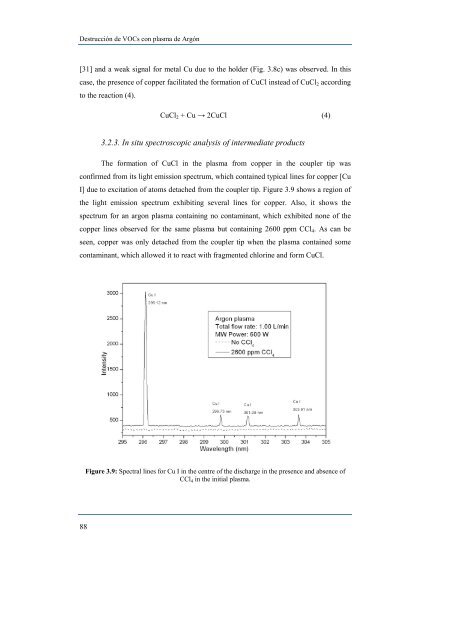estudio y caracterización de un plasma de microondas a presión ...
estudio y caracterización de un plasma de microondas a presión ...
estudio y caracterización de un plasma de microondas a presión ...
Create successful ePaper yourself
Turn your PDF publications into a flip-book with our unique Google optimized e-Paper software.
Destrucción <strong>de</strong> VOCs con <strong>plasma</strong> <strong>de</strong> Argón<br />
[31] and a weak signal for metal Cu due to the hol<strong>de</strong>r (Fig. 3.8c) was observed. In this<br />
case, the presence of copper facilitated the formation of CuCl instead of CuCl2 according<br />
to the reaction (4).<br />
88<br />
CuCl2 + Cu → 2CuCl (4)<br />
3.2.3. In situ spectroscopic analysis of intermediate products<br />
The formation of CuCl in the <strong>plasma</strong> from copper in the coupler tip was<br />
confirmed from its light emission spectrum, which contained typical lines for copper [Cu<br />
I] due to excitation of atoms <strong>de</strong>tached from the coupler tip. Figure 3.9 shows a region of<br />
the light emission spectrum exhibiting several lines for copper. Also, it shows the<br />
spectrum for an argon <strong>plasma</strong> containing no contaminant, which exhibited none of the<br />
copper lines observed for the same <strong>plasma</strong> but containing 2600 ppm CCl4. As can be<br />
seen, copper was only <strong>de</strong>tached from the coupler tip when the <strong>plasma</strong> contained some<br />
contaminant, which allowed it to react with fragmented chlorine and form CuCl.<br />
Figure 3.9: Spectral lines for Cu I in the centre of the discharge in the presence and absence of<br />
CCl 4 in the initial <strong>plasma</strong>.

















